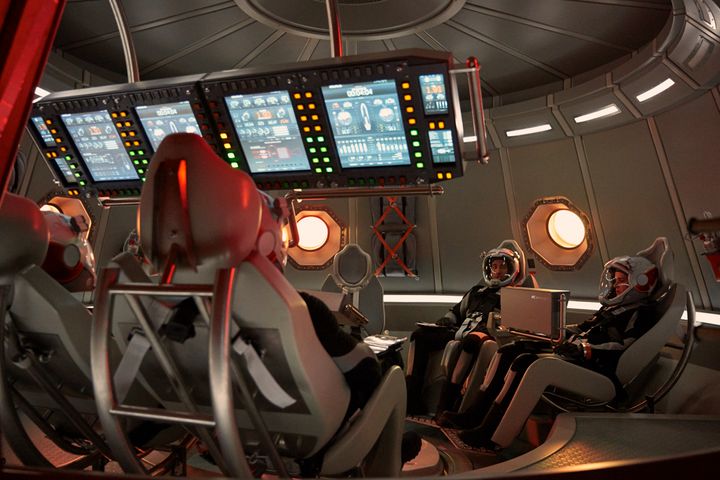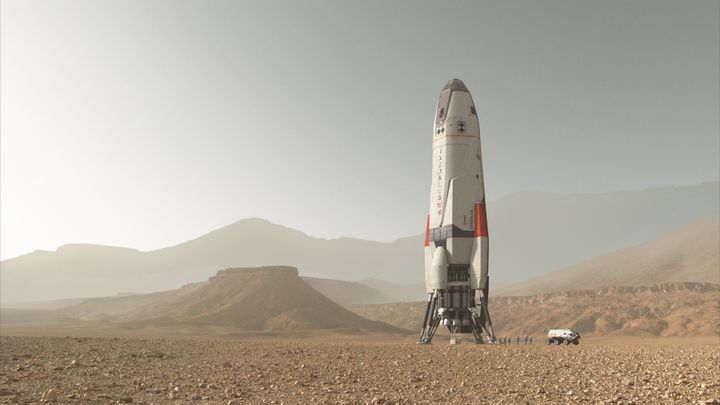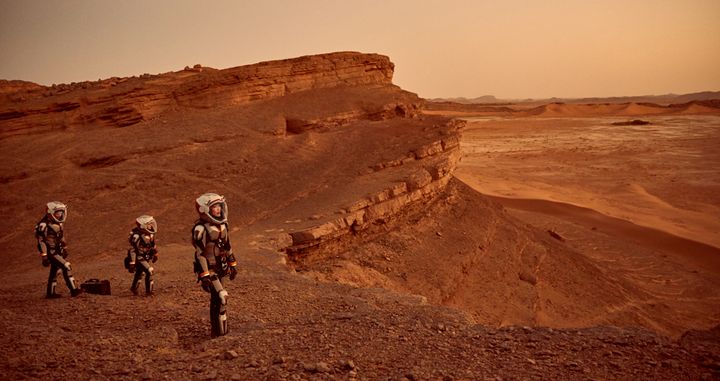Explore Mars and the possibility of humans setting foot on our nearest planetary neighbor on a new TV series premiering today on the National Geographic Channel. The program is aptly named, Mars.
The series takes place both in the present and the future. And although the futuristic portion dramatizes a fictional voyage to Mars in 2033, the series is based on present-day science and technology as applied to current Mars space programs. In fact, in order to highlight the science, and the possibilities, the series embraces a novel approach by mixing documentary and, what National Geographic calls, “feature-film-quality scripted drama.”

NASA is currently working towards sending people to Mars. Their goal is to get people into Mars orbit by the late 2030s. They are projecting a NASA astronaut will not set foot on the planet until the 2050s. Elon Musk, the founder and CEO of SpaceX, says his company is also seeking to take people to Mars. He outlined the details of his plans to the audience at a recent astronautics conference in Mexico.
In order to find out why we need to send humans to Mars, when we may actually get there, and who will get there first, I spoke with Dr. Robert Zubrin. He is an aerospace engineer and founder of the Mars Society, an organization that advocates for, and supports, private and public projects to send humans to Mars. He was also a consultant for Nation Geographic’s Mars series.

Dr. Robert Zubrin
Alejandro Rojas: Why is it important that humans go to Mars?
Dr. Robert Zubrin: Well, I think there are three reasons we need to take humans to Mars in our time. One is for the science. Mars is the Rosetta Stone for letting us know the truth about the potential prevalence and diversity of life in the universe. Mars was once a warm, wet planet, a place where life could have evolved. And the question is: “Does life evolve wherever it has a place where it can, or is it a matter of freak chance that it happens?”
If you put a cup of water outside when it is 20 degrees Fahrenheit, it is going to freeze. We know that for a fact. It is a natural process. It is going to happen. Water will turn to ice under appropriate physical conditions. If I have a planet with all of the correct physical conditions, will life happen, just like water turning to ice? Or, is there a natural process of scientific cause and effect that leads chemicals to complexify into complex molecules and then life, or was there just a one in a zillion event that happened here that made it happen?
We don’t know that right now, because we only have one example. We are like a family on an island that has won the lottery, and we don’t know anyone else. We don’t know if everyone wins the lottery or whether it is one in a billion. On the other hand, if you went to the other side of the island and you met a family that also won the lottery, you would have reason to believe it is something that happens to everyone.

View of the flight deck of the Daedalus spacecraft used to take astronauts to Mars in National Geographic's MARS series.
Also, if there is life on Mars, or was, is it something that is earth-like, or is it of a very different sort? In other words, are we what life is? Does everyone read or speak English, is English just one possible language, and not only that, are all earth languages one type of language and other things different, like wagging your tail as a form of language.
In other words, all life on Earth is the same at the biochemical level. We use the same amino acids, the same RNA, DNA system of communicating kinetic information. Is that what life is, or is that just one possible example of the way life could be? We find that out by taking people to Mars.
The second thing, going beyond the science, is the challenge itself. I believe civilizations are like individuals. We grow when we challenge ourselves, we stagnate when we do not, and the humans to Mars program would be a tremendous positive challenge for every country that engaged in it. We could say to every young person in every country that was part of the program, “Learn your science and you could be en explorer of new worlds.” Out of that challenge they would get millions of young scientists, engineers, inventors, doctors, medical researchers, technological entrepreneurs; the kinds of people that move science forward. That is an enormous investment and return of intellectual capital. It is worth doing. We should do it. We should do it for the challenge.
And finally, there is the future. The most important thing you do in your life, you do not do for yourself. It is what you do for the future, whether future ages or your own children, or something of the sort.

The interior of the Mars rover depicted in the program.
So, look. We are Americans. If I ask you right now what happened in 1492, what is your answer?
Rojas: That the Europeans came.
Zubrin: Particularly, Columbus discovered America for the Europeans and opened the door to the spreading of Western Civilization to the Western Hemisphere. So, we are very aware of that fact, but that is not the only thing in the world that happened in 1492. In 1492, the Borgias took over the papacy, which was the most powerful political institution in the world. If there had been big-time newspapers in 1492, that would have been the headliner, not Columbus. He would have been well in the back pages of the second section. But today, who cares about the Borgias taking over the papacy in 1492.
What I am saying is this. If we do this, if we establish that first human foothold on Mars in our time, then 500 years from now, there will not only be a new branch of civilization on Mars, but on thousands of planets orbiting stars on this part of the galaxy. And when they look back at this point, what will they think is the most important? Will they know about, or care, who won in Syria, or who won the election this week, or anything of that sort? No. But what we did that established the first human society on another planet. That is what will matter. This time will be remembered because this is when we set sail for other worlds.
Rojas: In the Mars program, they go to Mars in 2033. Do you think that timeline is realistic?
Zubrin: Sure. I hope it doesn’t take that long until we get to Mars. It doesn’t need to take that long before we get to Mars. From a technical point of view, we are much closer to being able to get to Mars than we were to get men to the Moon in 1961, and we were there 8 years later. If President Trump really wants to make American great again, he should commit the nation to land on Mars by the end of his second term, because we could do it. If he doesn’t do it, then it will be someone else to do it. But, there is no question, 2033 is a doable date for landing on Mars.

The Daedulus on Mars.
Rojas: A NASA engineer who works on the Orion capsule told me he would be ready, but he did admit there were issues, such as the radiation shielding they haven’t figured out. They are not even sure what they will do with that. Are there other large obstacles like that?
Zubrin: Well, actually, I disagree with that person. There are two kinds of radiation that can get you in space. One is solar flares, which are indeed dangerous, but you can shield against them using provisions like food and that which you will necessarily have on the ship if you are going to Mars. The other are cosmic rays, which are much more difficult to shield against because they are much more penetrating, but the amount you would get of them is predictable and it isn’t that large. It represents about a 1% risk of getting cancer on a round-trip Mars mission. If you consider the fact that the average American incurs a 20% chance of cancer by smoking, one would have to say that this is a modest portion of overall mission risk. So, I don’t see that as a major thing.
That said, sure there are lots of technical problems that need to be solved to send humans to Mars, but if we just take the thing as a whole, it is a much smaller technical problem than going to the moon was in the 1950s. It really is.
There are issues, but we are not talking about Los Alamos in 1943 where people are venturing into new realms of physics. This is a solvable problem. I would say landing on Mars is a smaller problem than the one Elon Musk just demonstrated by showing he could land the first stage of a rocket using its own engines. That wasn’t easy, but he did it.

Olivier Martinez as Ed Grann the French CEO of the Mars Mission Corporation looks on over Jihae as Joon Seung the Korean-American capsule communicator.
Rojas: That leads me to another question. Has the progress of the space tourism industry affected this timeline?
Zubrin: No. But what has is the development of technology by the Space X organization.
Rojas: I am not sure this is an either or question, but who will get there first, NASA or a private company?
Zubrin: Well, that is an interesting question. Right now Musk is Sputniking NASA. He is doing all sorts of things they’ve never done. On the other hand, he could wake them up. Just like we woke up when the Russians Sputniked us and we beat them to the moon.
So the question is, is NASA capable of being woken up? That will determine who gets there first.

Some of the crew exploring Mars.
Rojas: How is your organization, the Mars Society, helping to get people to Mars?
Zubrin: There are three things that we do. One is general outreach to spread the vision to take humans to Mars. Second, is political work to defend various Mars programs, both the robotic and human technology initiatives. Finally, we have done some projects of our own, such as building simulated Mars stations in the arctic and in the desert where crews are practicing and learning how to explore on Mars.
Of the three, the first, which is the least concrete and the hardest to measure, may be the most effective. After all, how did Elon Musk become who he is? Somebody gave him the idea, recruited him to the idea humans to Mars was one of the most important things he could be spending his life on. Ideas recruit people to their banner and these are all kinds of people, including people of great ability and resources like Musk, and also ordinary people. Who knows? Somebody in High School right now, who sees this National Geographic show, eight years from now could be a congressional aide who has control of appropriation in key technologies for a Mars probe and 20 years from now could be president. You never can tell the power of ideas except they are very powerful. Ultimately, things happen because people make them happen, and people make happen what they want to make happen and that is determined by the ideas that they have.
